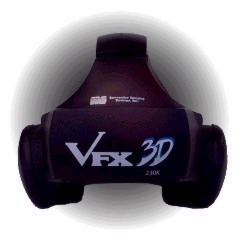|
HMDs, The ultimate hardware for PC simulation pilots?
Written by George
E. Warren Jr. |
||||
|
"The retail culture is not too forgiving for a smaller supplier either. As an example of this lets take a large chain like Fry's Electronics. A customer buys a VR headset and brings it home to play with. It's cool but he starts to get some buyers remorse because it does not look as good as his 15" monitor. " A week later, after playing with it -non-stop- he brings it back for a full credit. Well, it's no skin off of Fry's nose as they will only pay you for the stuff they sell. Well, if you're on 90 day terms with them, that pounds one stake in the lid of your coffin - delaying this payment further because of returns will pound a few more in. "VR has been overhyped and under delivered for a long time. The technology that lives up to the hype that was created in the press is just NOW being released in limited quantities. Panel technology just wasn't there until now.
While 180,000 pixel HMDs are cool, they did
not offer the gamer an advantage over using a comparably priced monitor with a
mouse or "Second, lack of title support. While it's neat to play one game with a headset, there has to be universal support for it - just like a mouse. It's too expensive for a specialized peripheral. While some of the HMD manufacturers did make some headway in increasing title support - it was never enough. "Consumer markets are a killer. The average computer user is sophisticated. They want high performance at an low cost. Consumer HMDs have come close to meeting their requirements. Industrial customers are willing to pay more and put up with deficiencies because they are making money with the HMD. "The guy at home is spending his hard earned money on it. He is fickle. He demands the best and wants to pay nothing for it. Computer manufacturers have cultivated and ingrained this expectation into everyone. It's tough to create a business model, that works, for this type of market. |
 VFX3D "Third, liability is an issue since there is no control over how long a person can use the HMD. Humans adapt to things very quickly. The suspected root of CyberSickness - a vestibular imbalance, increasingly manifests itself in a user the longer they are immersed." The imbalance occurs when a user, immersed in a virtual world, is sending mixed signals to their brain. Their eyes are saying they are moving while their inner ear is saying they are not moving. The brain develops a new neural pathway to reprocess the information. This can cause nausea. The effect can be replicated in an IMAX theater or with a monitor in a dark room."
Dave Kanahele "There have been "low cost" (<$1K) HMDs on the market for a couple of years now, but their performance has been disappointing to say the least. Also, "low cost" is relative. Military HMDs can run well over $100K. Even at $699, HMDs for the consumer market are "expensive" - especially considering the falling prices and quality of monitors these days. "Then there is the cost of the head tracker and lack of software support. Here at KEO we concentrate on the industrial and military markets. No doubt, however, others are looking at consumer markets considering the multi-billion dollar gaming markets. These include Sony and others. And yes, liability is a significant concern." GO to Page Four.
|
|||
|
Copyright © 1997 - 2000 COMBATSIM.COM, INC. All Rights Reserved. Last Updated November 5th, 1999 |
||||
